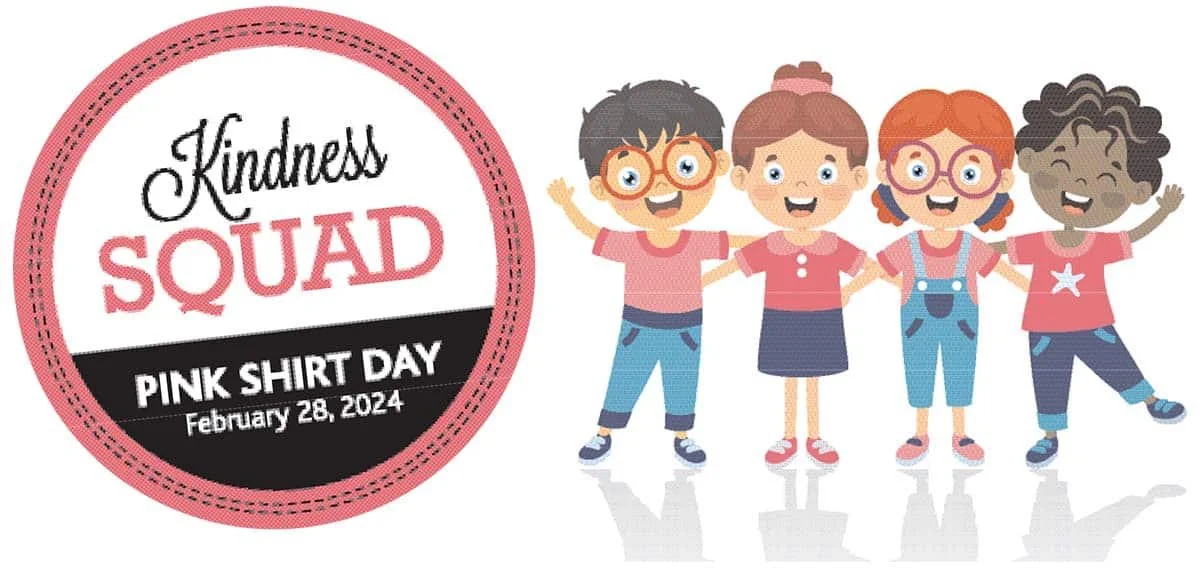Kindness Squad: Pink Shirt Day, Feb 28
CULTURAL DIFFERENCES and bullying
Bullying is a problem that happens all over the world and isn’t limited to one culture. Because different cultures communicate differently, culture can affect how bullying is expressed. Here’s an overview of some ways bullying may differ according to culture.
Tolerance for aggression. Different cultures have different attitudes toward aggression and ways of resolving conflicts. This can impact the frequency and normalization of bullying in a community.
Communication styles. Some cultures might be more direct, with loud speech and expressive emotions. However, others might use more subtle forms of aggression, like gossip or social exclusion.
Power distance. In cultures where there’s a big difference in power between people, bullying might be more hierarchical. For example, a boss might use their position to bully a staff member.
Collectivism vs. individualism. In cultures where it’s more important to think about the group, bullying might be more grouporiented. In cultures where individuality is valued,bullyingmightbemoreone-on-one.
Responses to bullying. How individuals respond to bullying can vary. Some cultures might encourage people to handle bullying on their own, and others might encourage people to seek help from other members of the community.
Understandingthesecultural differences is essential to creating anti-bullying initiatives that work for everyone, no matter their cultural background.
EMPATHY: How to combat bullying through kindness
Understanding and sharing the emotions of others is what empathy is all about. When it comes to bullying, you can gain valuable insight into someone else’s struggles and emotions by putting yourself in their shoes. Here’s how to fight bullying with empathy.
Listen. Take the time to genuinely listen to others, especially those who may feel isolated or vulnerable. By showing empathy and understanding, you can create a safe space for people to share their experiences and feelings.
Reach out. If you notice someone being bullied, offer a helping hand and let them know they’re not alone. Even small acts of kindness can have a significant impact on someone’s life.
Lead by example. Treat everyone with respect and understanding. Your actions can inspire positive change and create a ripple effect of kindness and compassion.
Encourage inclusivity. Embrace diversity and create an inclusive environ-
ment where everyone feels valued and accepted for who they are. Celebrate differences and encourage people to share their unique perspectives and experiences.
Raise your voice. If you witness bullying, don’t hesitate to intervene. Simply standing up for someone can diffuse a harmful situation and create a sense of safety and security.
This Pink Shirt Day, lead with empathy. Taking the time to understand others will lead to a kinder and more compassionate society.
How to overcome THE TRAUMA OF PAST BULLYING
Dealing with the aftermath of bullying can be challenging. However, with persistence and support, it’s possible to move forward. Here are some essential steps.
1. Acknowledge the trauma. Recognizing how bullying has affected your life is essential to moving forward. By accepting this reality, you can begin the healing process.
2. Build a support system. Connect with empathetic friends, family members or support groups who can offer validation, comfort and encouragement. Sharing your bullying experience with others who have faced similar challenges can help reduce feelings of isolation.
3. Develop self-compassion. Be kind and forgiving to yourself to overcome any shame or guilt. Take time for self-care and prioritize your personal growth to foster resilience and strength.
4. Celebrate progress. Recognize and celebrate each milestone achieved in the healingjourney.Acknowledgingyourprogress can help motivate you to continue
moving forward. Every step forward is a victory to be proud of.
5. Seek professional help. A therapist or counsellor who specializes in bullying trauma can provide a safe space for you to process emotions and develop coping strategies. Professional guidance can be crucial in helping you find peace.
Above all, remember that you aren’t alone. With determination and support, you can overcomepastbullying.Keeppushingforward and never give up on yourself.
4 tips for supporting MARGINALIZED GROUPS
Supporting marginalized groups who face bullying and discrimination is a crucial piece of creating a more inclusive and equitable society. These groups include people with disabilities, people of colour, LGBTQ+ individuals and Indigenous people. Here are some helpful tips to make a positive difference.
1. Listen and learn. Take the time to actively listen to the stories and experiences of marginalized individuals. Educate yourself about the challenges they face, their history and their unique perspectives.This knowledge is a powerful tool for empathy and understanding.
2. Educate others. Share what you’ve learned about marginalized groups with your friends, family and acquaintances. Encourage others to join you in supporting these communities to create a ripple effect of positive change.
3. Use your privilege. Recognize any advantages you may have related to your
race, gender or socio-economic status. Use your privilege to amplify the voices of marginalized groups, advocate for policychangeandchallengediscrimination.
4. Be an ally. Stand up for marginalized communities, even when you aren’t directly affected. Speak out against injustice, discrimination and microaggressions when you witness them.
Finally, continuous self-examination of prejudices and blind spots is essential. Growth requiresself-awareness,andacknowledging your own biases is the first step toward standing up and ending bullying for marginalized groups.

